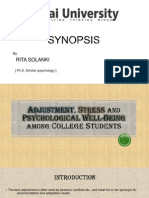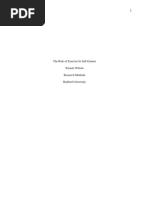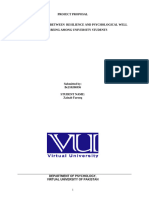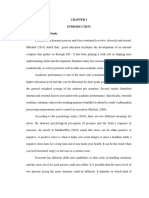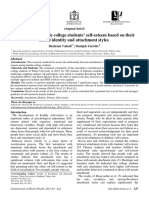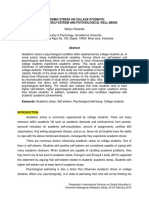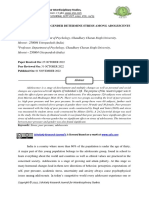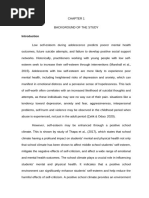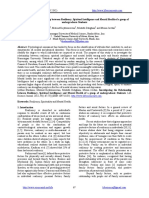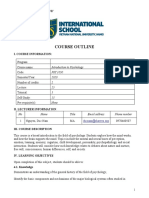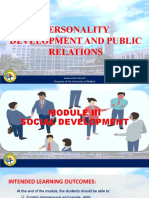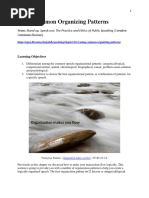48 KC Barmola
48 KC Barmola
Uploaded by
priyankasotiaCopyright:
Available Formats
48 KC Barmola
48 KC Barmola
Uploaded by
priyankasotiaOriginal Title
Copyright
Available Formats
Share this document
Did you find this document useful?
Is this content inappropriate?
Copyright:
Available Formats
48 KC Barmola
48 KC Barmola
Uploaded by
priyankasotiaCopyright:
Available Formats
© Journal of the Indian Academy of Applied Psychology
September 2024, Special Issue, 483-490
Association between Self Esteem, Resilience,
Spirituality and Stress
KC Barmola
SRM University, Sonepat Haryana
Vaishali Saini
Manastha Health Solutions Private Ltd, India
Stress and lower self-esteem are amongst the top factors taking a toll on mental health
of youth nowadays. This led to numerous researches to find ways to handle it. The
current study attempted to find the relationship spirituality, self esteem and resilience
can help students to overcome this stress. To find the aim of the study a sample 150
College Students were selected purposively of Haryana, India. All the respondents
were within the age group of 17- 26 years. To measure self esteem, resilience, spirituality
and stress among college student Self-Esteem Scale by Rosenberg (1965), Brief
Resilience Scale by Smith (2008), Daily Spiritual Experience scale by Underwood &
Teresi (2002) and Student Stress Inventory by Mohamed Arip et al (2015) were used.
Results of the study suggests that there was a significantly positive relationship between
self-esteem and resilience (rs = .385, p<.01). There was also found significantly negative
relationship between self-esteem and stress (rs = -.362, p<.01); resilience and stress
(rs = -.353, p<.01), and self-esteem and spirituality (rs = -.232, p<.01). Another finding
says there is no significant relationship between spirituality and stress (rs = .127,
p<.01), and spirituality and resilience (rs = -.054, p<.01). It may be concluded that self
esteem resilience have important role in managing stress while spirituality does not
any association with stress.
Keywords: Self-Esteem, Resilience, Spirituality, Stress, Adolescents
Stress and lower self-esteem are amongst stress in past 12 months. Digging deeper with
the top factors taking a toll on mental health this fact, there can be many factors that are
of youth nowadays. Indulging with numerous directly or indirectly related to stress coping
people during college days can offer many and bearing skills, mainly to mention are self-
ups and downs to students. From being esteem, resilience and spirituality. Eisenbarth
thrilled by small victories to questioning self- (2012) came up with the facts of college
worth in the low times, the drive to battle students and mentioned the relationship
challenges goes off track. Managing stress between self-esteem and stress coping,
in such crucial times to seek personal well- stating that if an individual doesn’t believe in
being, academ ic excellence, develop his capability or consider himself worthy or
interpersonal relationships becomes very significant, the perceived stress levels can
important, so that; they can become capable be heightened which may lead to depressive
individuals who contribute to environment symptoms.
and humanity. According to American College
The main purpose to take up this research
Health Association, National College Health
is to identify and discuss the root cause of
Assessment II (2018) survey, only 1.6 percent
one of major problems prevailing in society.
of college students reported absence of
JOURNAL OF THE INDIAN ACADEMY OF APPLIED PSYCHOLOGY, SEPTEMBER 2024 483
Individuals in colleges tend to compare dropouts. The findings suggested positive
themselves with others and forget their significant correlation between protective
unique identity they are born with and factors and resilience, positive relationship.
undergo tremendous stress and emotional Sethi et al (2013) studied role of yoga in
vulnerability. When one respects one’s lives improving attention and self-esteem and
from deep within, tend to respect people in found that Yogic practices like asana,
their environment and become resilient and pranayama, vedic chanting, and meditation
spiritual and focus on polishing our character may improve adjustment among chronically
as human being. The area of focus is just to stressed and disadvantaged students by
identify the deadlocks and restoring their enhancing self-esteem. Jain & Dixit (2014)
lives deep within. College population is mostly examined gender-based comparison and the
protected in a shell during school days by causal factors and revealed that there was
families and friends. The real battle starts no significant gender difference in the self-
when one is exposed to vulnerability of life. A esteem levels of the participants. The causal
review details the typical trajectory of incidents reducing self-esteem levels were
emotional experience during adolescence. divided into four themes, based on, unmet
Adolescents experience changes in a variety expectation; from personal self, from social
of emotional dimensions, with different self, at home and at school/college. Kumar
patterns emerging in adolescents of different & Singh (2014) examined the resilience and
ages, genders, and pubertal stages. (Bailen spirituality and found that psychological well-
et al., 2019). being is predicted by both resilience as well
as spirituality among students. This shows
Carter & Garber (2011) studied the onset
that students who were resilient and had
of a major depressive episode and changes
strong spiritual approach in their lives
in depressive symptoms across adolescence
reported higher levels of psychological well-
and found that low self-esteem and low self-
being.
worth are associated with stress and
depression. Both of them constitute risk Reddy et al (2015) examined self-esteem
factors for appearance of depression, as and stress among private and government
people cannot manage and cope with the high school students. Results revealed that
stressful life events. students from government and private
schools don’t have any difference on self-
Kim & Esquivel (2011) investigated
esteem and stress. Students from both
adolescent spirituality and resilience. Results
schools had low level of stress and normal
suggested that spirituality promotes healthy
level of self-esteem. Athulya et al (2016)
development in adolescents, enhances the
studied procrastination, perfectionism,
ability to cope, and leads to positive
coping and their relation to distress and self-
outcomes in mental health, psychological well
esteem in college students. Maladaptive
being, and academic learning.
perfectionism emerged as a significant
Sood et al. (2011) examined the stress predictor of both distress and lower self-
management and resilience training and esteem. Bakhshi et al (2017) examined self-
suggested that the intervention has a esteem and resiliency between blind and
potential to improve resiliency, stress, sighted children and adolescents. The
anxiety, and quality of life among physicians. results showed that there was no significant
Mehrotra & Chaddha (2013) examined a difference in between the two, blind and
co-relational study of protective factors, sighted group in the resilience rate, but there
resilience and self-esteem in pre medical was a significant level of difference in Self-
484 JOURNAL OF THE INDIAN ACADEMY OF APPLIED PSYCHOLOGY, SEPTEMBER 2024
esteem among blind and sighted people, consisted of 10-item which measures global
which shows that disability exists not only in self-worth by measuring both positive and
the body of people with disabilities, but also negative feelings about the self. All items are
in the attitudes of those individuals. Tian et answered using a 4-point Likert scale format
al (2018) studied parent–child relationships ranging from strongly agree to strongly
and resilience among Chinese adolescents. disagree. The scores obtained from this
The results indicated that the associations instrument can range from 0-30. The
between parent–child relationships and Reliability of the RSES ranges from 0.77 to
adolescent resilience were primarily mediated 0.88, and validity is 0.55
by self-esteem and that parental support was
Brief Resilience Scale (Smith et al, 2008):
more robustly linked with adolescent
The B.R.S is comprised of 6 items, half of
resilience than parent–adolescent conflict.
them formulated positively and half of them
Harikrishnan & Ali (2018) studied refer to negative events: difficult periods,
resilience, psychological distress, and self- stressful events, disappointments.
esteem among Undergraduate Students in Participants responded on a 5-point Likert
Kerala. Results revealed that psychological scale, ranging from 1 (Strongly Disagree) to
distress and self-esteem among university 5 (Strongly Agree). The scores obtained from
students is associated with resilience. Mitra this instrument can range from 1-30. The
(2020) examined a model for a deeper reliability of the used scale is .83.
understanding of the predictive factors of
Daily Spiritual Experience scale
resilience and found a partial role of self-
(Underwood & Teresi, 2002): The Daily
esteem in mediating the relation between
Spiritual scale consisted of 15-item, self-
spiritual health and resilience.
report measure of spiritual experience. The
Objective of the study first 14 items of the questionnaire are
To find the association between the study measured on a 6-point Likert-type scale:
variables Self-Esteem, Resilience Spirituality many times, a day, every day, most days,
and Stress some days, once in a while, and never or
almost never. Item 15 is measured on a 4-
Hypothesis point scale: Not Close at All, Somewhat
There will be significant correlation Close, Very Close, As Close as Possible.
between study variables- Self Esteem, DSES reliability scores were high 0.85.
Resilience Spirituality and Stress Student Stress Inventory (Arip et al,
Method 2015): This scale is used to measure the
level of stress among university students.
Sample The SSI was designed with ordinal scale of
The sample comprised of College the ‘Never’, ‘somewhat frequent’, ‘Frequent’
Students chosen purposively from various and ‘Always’. The overall validity is 0.805.
educational colleges of Haryana in India. The The reliability of SSI had a high reliability
Sample size consisted of 150 participants. coefficient of .857.
All the respondents were within the age group Results and Discussion
of 17- 26 years.
To measure the relationship between
Tools different variables of the study Spearman’s
Rosenberg Self-Esteem Scale rho non parametric test of correlation is
(Rosenberg, 1965): The complete scale analyzed. Correlation is used to calculate the
JOURNAL OF THE INDIAN ACADEMY OF APPLIED PSYCHOLOGY, SEPTEMBER 2024 485
strength and direction of the relationship that academic resilience can have a big
between the different study variable’s self impact when internal and external support
esteem, resilience, spirituality and stress. conditions are met, which the consequences
The value of r s in Table 2 represents the are often reinforced when family support, a
assessment of correlation strength between learning environment, and improved
two variables. If the numerical value of adaptability to life at college also are provided
correlation falls between 0 to 0.2 is generally (Shin, 2016). Another study performed by
considered weak. Table 2 shows the (Kennedy et al, 2018) showed that loss of a
statistical analysis reports computed by parent or sibling in childhood conferred an
SPSS. Having calculated Spearman rho in the increased risk of subsequent low stress
current study as shown in Table no 2 that resilience and an increased risk of moderate
can be summarized in following points: stress resilience in late adolescence.
Spearman’s Rho correlation coefficient Spearman’s Rho correlation coefficient
was calculated to measure the relationship was calculated to measure the relationship
between self-esteem and resilience. There between self-esteem and spirituality. There
was a significantly positive relationship was found a significantly negative
between self-esteem and resilience (r s = relationship between self-esteem and
.385, p<.01). It shows an increase in self spirituality (r s = -.232, p<.01). This
esteem will lead to an increase in resilience. significantly found negative correlation of the
current study shows an increase in the self
Spearman’s Rho correlation coefficient
esteem m ay lead to decrease in the
was calculated to measure the relationship
spirituality. This finding is supported by
between self-esteem and stress. There was
(Gabova et al., 2021) which showed that
found a significantly negative relationship
while religious/spiritual respondents did not
between self-esteem and stress (rs = -.362,
differ significantly from non-religious
p<.01). It shows an increase in self esteem
respondents, religious/non-spiritual
will lead to decrease in stress. A study shows
respondents had approximately 79% lower
a similar result that, low-self-esteem
chance of having good self esteem.
individuals are especially vulnerable to
unstable and negative circumstances Table 1. Descriptive Statistics
because their feelings of self-worth tend to
N Min. Max. Mean Std.
drop under failure, they are more concerned
Deviation
about self-protection in stressful situations,
and they are more likely to have depressive Resilience 150 1.66 26.00 3.2937 1.96192
attributions in response to negative event Self-esteem 150 9.00 30.00 18.9467 4.17533
(Nima et al, 2013). Another study by Orth et
al (2014) also found that people with low self- Spirituality 150 16.70 96.70 51.0447 16.45552
esteem react with more stress in several Stress 150 40.00 134.00 73.5733 17.78709
stressful situations.
Spearman’s Rho correlation coefficient Spearman’s Rho correlation coefficient
was calculated to measure the relationship was calculated to measure the relationship
between resilience and stress. There was between spirituality and stress. There was
found a significantly negative relationship found no relationship between spirituality and
between resilience and stress (rs = -.353, stress (rs = .127, p<.01). It shows that there
p<.01). It shows an increase in resilience will is no role of spirituality in managing stress
lead to decrease in stress. A study showed among college students.
486 JOURNAL OF THE INDIAN ACADEMY OF APPLIED PSYCHOLOGY, SEPTEMBER 2024
Table 2. Correlations
Resilience Self-esteem Spirituality Stress
Spearman’s rho Resilience Correlation Coefficient 1.000 .385** -.054 -.353**
Sig. (2-tailed) . .000 .513 .000
N 150 150 150 150
Self-esteem Correlation Coefficient .385 **
1.000 -.232 **
-.362**
Sig. (2-tailed) .000 . .004 .000
N 150 150 150 150
Spirituality Correlation Coefficient -.054 -.232** 1.000 .127
Sig. (2-tailed) .513 .004 . .122
N 150 150 150 150
Stress Correlation Coefficient -.353** -.362** .127 1.000
Sig. (2-tailed) .000 .000 .122 .
N 150 150 150 150
**Correlation is significant at the 0.01 level (2-tailed).
An Indian study by Yadav, and Khanna current study. First hypothesis of no
(2014) also supported the current study relationship between self esteem and
finding which showed that there is negative resilience was rejected because there was
correlation (r = -0.519) between the stress statistically significant relationship was found
and spirituality of engineering students. (r s = .385, p<.01). This finding is also
Spearman’s Rho correlation coefficient supported the literature. Karatas & Cakar
was calculated to measure the relationship (2011) findings showed that self-esteem and
between spirituality and resilience. There hopelessness is a significant predictor of
was found no relationship between spirituality resilience in adolescents. There was a
and resilience (rs = -.054, p<.01). It shows positive relationship between self-esteem and
that there is no role of spirituality in resilience resilience. Relationship between self esteem
among college students. This could be due and stress was also found negatively
to health issues, a related study found a significant (rs = -.362, p<.01) which is also
weak to moderate correlation between supported by the study that shows low-self-
spirituality and resilience in respondents with esteem individuals are especially vulnerable
health problems or suffered from chronic to unstable and negative circumstances
diseases and productive respondents (Dewi because their feelings of self-worth tend to
& Hamzah, 2019). drop under failure, they are more concerned
Hypotheses of the current study stated about self-protection in stressful situations,
that there would be no significant relationship and they are more likely to have depressive
between different study variables. To test attributions in response to negative event
these hypotheses statistical analysis was (Nima et al, 2013). Another study by Orth et
done with the help of Spearman Rho in the al (2014) also found that people with low self-
JOURNAL OF THE INDIAN ACADEMY OF APPLIED PSYCHOLOGY, SEPTEMBER 2024 487
esteem react with more stress in several Conclusion
stressful situations. In view of association The current study had aimed to find
between resilience and stress, a negatively relationship between different study variable-
significant relationship was found (rs = -.353, Self-Esteem, Resilience Spirituality and
p<.01) in the current study. Which means Stress. One of the results of study suggests
resilient student will have less chances of that there was a significantly positive
stressful life experience than those who are relationship between self-esteem and
not resilient. Study by Shin (2016) and resilience. In another finding also a
Kennedy et al, (2018) reported similar significantly negative relationship was found
results. between self-esteem and stress; resilience
and stress, and self-esteem and spirituality.
Hypothesis of no relationship between self
It was also found no significant relationship
esteem and spirituality was accepted in the
between spirituality and stress, and
current study findings (r s = -.232, p<.01).
spirituality and resilience in the current study.
W hich means there does not have any
Therefore, it may be concluded that self-
relationship between self esteem and esteem and resilience have important role in
spirituality among college students. In other managing stress among college students
word it can be said that self worth does not while spirituality does not any association with
matter among college students for spirituality stress.
or vice versa. There was not found any
significant relationship between spirituality References
and stress (rs = .127, p<.01) among college Association-National College Health Assessment
students. Therefore, it can be said that II: Reference Group Executive Summary
spirituality does not contribute much in Spring (2018). Silver Spring, MD: American
College Health Association
managing stressful life events. No association
was found between spirituality and resilience Athulya, J., Sudhir, P. M., & Philip, M. (2016).
(rs = -.054, p<.01). It shows that there is no Procrastination, perfectionism, coping and
their relation to distress and self-esteem
role of spirituality in resilience among college
in college students. Journal of the Indian
students. Academy of Applied Psychology, 42(1), 82.
Recommendations Arip, M.A.S.M., Kamaruzaman, D. N., Roslan,
Following are some of the A., Ahmad, A. and Rahman, M.R. A.
recom mendations to adolescents and (2015). Development, Validity and
Reliability of Student Stress Inventory
different stakeholders in their life.
(SSI). The Social Sciences, 10, 1631-
Adolescents need to be involved in 1638.
creative and innovative activities to Bakhshi, S., Montazeri, N., Nazari, B., Ziapour,
explore one’s potentials to understand A., Barahooyi, H., &Dehghan, F. (2017).
self worth that consequently may help Comparing the self-esteem and resiliency
to increase their self-esteem. between blind and sighted children and
adolescents in Kermanshah City. World
Adolescents need to be given internal Family Medicine Journal: Incorporating the
and external support from family, friend Middle East Journal of Family Medicine,
and society to boost their resilience 99(5489), 1-6.
which consequently will help to fight with
Bailen, N. H., Green, L. M., & Thompson, R. J.
challenges and changes of the worlds. (2019). Understanding Emotion in
Adolescents: A Review of Emotional
488 JOURNAL OF THE INDIAN ACADEMY OF APPLIED PSYCHOLOGY, SEPTEMBER 2024
Frequency, Intensity, Instability, and Mehrotra, S., & Chaddha, U. (2013). A co-
Clarity. Emotion Review, 11(1), 63- 73. relational study of protective factors,
resilience and self-esteem in pre medical
Carter, J. S., & Garber, J. (2011). Predictors of
dropouts. International Journal of
the First Onset of a Major Depressive
Humanities and Social Science Invention,
Episode and Changes in Depressive
2(9), 103-106.
Symptoms across Adolescence: Stress
and Negative Cognitions. Journal of Mitra, B. (2020) Spiritual Health and Resilience
Abnormal Psychology, 120, 779-796. Among University Students: the Mediating
Role of Self-Esteem. Pastoral Psychology
Dewi, D.S.E & Hamzah, H.B (2019) Advances in
69(1), 1-13 DOI: 10.1007/s11089-019-
Social Science, Education and
00889-y
Humanities Research, 349, 145-147.
Nima, A. A., Rosenberg, P., Archer, T., & Garcia,
Eisenbarth, C. (2012). Does self-esteem
D (2013). Anxiety, Affect, Self-Esteem, and
moderate the relations among perceived
Stress: Mediation and Moderation Effects
stress, coping, and depression? College
on Depression. PLoS ONE, 8, e73265.
Student Journal, 46(1).
Orth, U., Robins, R. W., W idaman, K. F., &
Gabova, K., Malinaaova, K., Tavel, P (2021)
Conger, R. D. (2014). Is Low Self-Esteem
Associations of Self-Esteem with Different
a Risk Factor for Depression? Findings
Aspects of Religiosity and Spirituality.
from a Longitudinal Study of Mexican-
Ceskoslovenska Psychologie, LXV (1)
Origin Youth. Developmental Psychology,
DOI: 10.51561/cspsych.65.1.73
50, 622-633. http://dx.doi.org/10.1037/
Harikrishnan, U. & Ali, A. (2018) Resilience, a0033817
Psychological Distress, and Self-Esteem
Reddy, S., Kannekanti, P., & Hamza, A. (2015).
among Undergraduate Students in Kollam
A comparative study on self-esteem and
District, Kerala. Journal of Social Work
stress among private and government high
Education and Practice, 3(4), 27-36.
school students. International Journal of
Jain, S., & Dixit, P. (2014). Self Esteem: A Research and Scientific Innovation
gender-based comparison and the causal (IJRSI), 2(3), 18-22.
factors reducing it among Indian youth.
Rosenberg, M. (1965). Society and the
International Journal of Humanities and
adolescent self-image. Princeton, NJ:
Social Science Invention, 3(4), 09-15.
Princeton University Press.
Kennedy, Beatrice., Chen, Ruoquing.,
Shin, S. H. (2016). The effect of academic stress
Valdimarsdottir, Unnur., Montgomery,
and the moderating effects of academic
Scott., Fang, Fang., & Fall, Katja. (2018).
resilience on nursing students’ depression.
Childhood Bereavement and Lower Stres
J Korean Acad Soc Nurs Educ, 22(1), 14.
Resilience in Late Adolescence. Journal
of Adolescent Health,63(1), 108-114. Sood, A., Prasad, K., Schroeder, D., &Varkey,
P. (2011). Stress management and
Kim, S., & Esquivel, G. B. (2011). Adolescent
resilience training among Department of
spirituality and resilience: Theory,
Medicine faculty: a pilot randomized
research, and educational practices.
clinical trial. Journal of general internal
Psychology in the Schools, 48(7), 755–
medicine, 26(8), 858-861.
765. https://doi.org/10.1002/pits.20582
Sethi, J. K., Nagendra, H. R., & Ganpat, T. S.
Kumar, U., & Singh, R. (2014). Resilience and
(2013). Yoga Improves Attention and Self-
Spirituality as Predictors of Psychological
Esteem in Underprivileged Girl Student.
Well-Being among University Students.
Journal of Education and Health
Journal of Psychosocial Research, 9(2).
Promotion, 2, 55.
JOURNAL OF THE INDIAN ACADEMY OF APPLIED PSYCHOLOGY, SEPTEMBER 2024 489
Smith, B. W., Dalen, J., Wiggins, K., Tooley, E., Underwood, L. G. & Teresi, J. (2002). The Daily
Christopher, P., & Bernard, J. (2008). The Spiritual Experience Scale: Development,
brief resilience scale: assessing the ability theoretical description, reliability,
to bounce back. International journal of exploratory factor analysis, and preliminary
behavioral medicine, 15(3), 194-200. construct validity using health related data.
Tian, L., Liu, L., & Shan, N. (2018). Parent–child Annals of Behavioral Medicine, 24, 22-33.
relationships and resilience among Yadav, R & Khanna, A. (2014) Impact of Spirituality
Chinese adolescents: The mediating role on Stress: With the Special Reference of
of self-esteem. Frontiers in psychology, 9, Engineering Students of Indian Institute of
1030. Technology. Research on Humanities and
Social Sciences, 4, (25), 29-36
KC Barmola, PhD., Associate Professor, Department of Psychology, SRM University
Sonepat Haryana
Vaishali Saini, Psychologist, Manastha Health Solutions Private Ltd, India
490 JOURNAL OF THE INDIAN ACADEMY OF APPLIED PSYCHOLOGY, SEPTEMBER 2024
You might also like
- Depression, Anxiety and AcademDocument5 pagesDepression, Anxiety and AcademSassy BlaireNo ratings yet
- Ead 520 Benchmark Schoolwide Character Education Proposal 1Document15 pagesEad 520 Benchmark Schoolwide Character Education Proposal 1api-309737337100% (6)
- Review of LiteratureDocument4 pagesReview of LiteratureGeetha PriyaNo ratings yet
- A Correlational Study of Self-Esteem, Stress and Academic Achievement Among College StudentsDocument4 pagesA Correlational Study of Self-Esteem, Stress and Academic Achievement Among College StudentsgwenstacyNo ratings yet
- Acad Stress S E Fam E sYNOPSISDocument13 pagesAcad Stress S E Fam E sYNOPSISignou helpNo ratings yet
- IMRAD FormatDocument4 pagesIMRAD FormatMarie Kaye-Anne De LeonNo ratings yet
- Medi 100 E24334Document8 pagesMedi 100 E24334Just a GirlNo ratings yet
- Research Paper2Document8 pagesResearch Paper2Upendra Kumar PrajapatiNo ratings yet
- Resilience and Empathy As PredictorsDocument10 pagesResilience and Empathy As PredictorsRicardoNo ratings yet
- The Relationship Between Optimism Andpsychological Well-Being of Class X Studentssman1gondangDocument5 pagesThe Relationship Between Optimism Andpsychological Well-Being of Class X Studentssman1gondangAJHSSR JournalNo ratings yet
- Academic Stress and Mental Health Among High School StudentsDocument4 pagesAcademic Stress and Mental Health Among High School StudentsclndneNo ratings yet
- BPJ Vol 11 No 1 P 531-537Document8 pagesBPJ Vol 11 No 1 P 531-537pyong jNo ratings yet
- 2017 Rzlnce, SDTDocument15 pages2017 Rzlnce, SDTShahzad AliNo ratings yet
- The Relationship Between Anxiety and Self-Esteem Among Senior High School StudentsDocument7 pagesThe Relationship Between Anxiety and Self-Esteem Among Senior High School StudentsPsychology and Education: A Multidisciplinary JournalNo ratings yet
- Rita Solanki: (Ph.D. Scholar (Psychology) )Document12 pagesRita Solanki: (Ph.D. Scholar (Psychology) )tusharhrmNo ratings yet
- Introduction SectionDocument7 pagesIntroduction SectionxnjwfkfbtbNo ratings yet
- 19-21 Yrs Self Efficacy, Esteem Adjustment GirlsDocument8 pages19-21 Yrs Self Efficacy, Esteem Adjustment GirlsAdhya DubeyNo ratings yet
- The Relationship Between Happiness and Depression Among Senior High School Students Amidst The COVID-19 PandemicDocument6 pagesThe Relationship Between Happiness and Depression Among Senior High School Students Amidst The COVID-19 PandemicPsychology and Education: A Multidisciplinary JournalNo ratings yet
- Research InstrumentsDocument29 pagesResearch Instrumentsishika ajayNo ratings yet
- Relationship of Academic Performance and Well Being in University StudentsDocument5 pagesRelationship of Academic Performance and Well Being in University StudentsiobiwoleNo ratings yet
- Adolescents' Covitality Patterns - Relations With Student Demographic Characteristics and Proximal Academic and Mental Health OutcomesDocument16 pagesAdolescents' Covitality Patterns - Relations With Student Demographic Characteristics and Proximal Academic and Mental Health OutcomesnonafraidNo ratings yet
- The Moderating Effect of Self-Esteem On The Relationship Between Perceived Social Support and Psychological Well-Being Among AdolescentsDocument14 pagesThe Moderating Effect of Self-Esteem On The Relationship Between Perceived Social Support and Psychological Well-Being Among AdolescentsPsychology and Education: A Multidisciplinary JournalNo ratings yet
- Body Image Dissatisfaction andDocument5 pagesBody Image Dissatisfaction andhaanh190605No ratings yet
- Ijm 11 01 015Document12 pagesIjm 11 01 015IAEME PublicationNo ratings yet
- Peer Pressure and Self - Confidence Among Senior High School Students of The University of The Immaculate ConceptionDocument17 pagesPeer Pressure and Self - Confidence Among Senior High School Students of The University of The Immaculate ConceptionLuna AndraNo ratings yet
- Research Proposal: 1.0 Statement of The ProblemDocument8 pagesResearch Proposal: 1.0 Statement of The ProblemselbalNo ratings yet
- Dizertatie 3Document5 pagesDizertatie 3Monica TeletinNo ratings yet
- Academic Stress and Mental Health AmongDocument3 pagesAcademic Stress and Mental Health Amongminhtuyet20041206No ratings yet
- 681-Article Text-749-1-10-20230724Document6 pages681-Article Text-749-1-10-20230724Thảo Ngân TrầnNo ratings yet
- BPJ Vol 11 No 1 P 531-537Document7 pagesBPJ Vol 11 No 1 P 531-537Andreea0% (1)
- Academic Stress among Students- Spirituality as a ToolDocument27 pagesAcademic Stress among Students- Spirituality as a ToolanitaroogeNo ratings yet
- Proposal Zainab FarooqDocument21 pagesProposal Zainab Farooqteyyabakhan565No ratings yet
- Research TitleDocument4 pagesResearch TitleMARK WILLIE ABADNo ratings yet
- Lee Et Al (2024)Document14 pagesLee Et Al (2024)Kyo learnNo ratings yet
- The Mediating Effect of Belongingness On Self-Esteem and Positive Mental Health of College StudentsDocument10 pagesThe Mediating Effect of Belongingness On Self-Esteem and Positive Mental Health of College StudentsPsychology and Education: A Multidisciplinary JournalNo ratings yet
- Chapter 1 and 2 Group 4Document19 pagesChapter 1 and 2 Group 4CHRISTIAN CALAMBANo ratings yet
- Depression, Anxiety, and Stress in Relation To Life Satisfaction and Academic Performance of AdolescentsDocument4 pagesDepression, Anxiety, and Stress in Relation To Life Satisfaction and Academic Performance of AdolescentsSana SajidNo ratings yet
- Background of The StudyDocument7 pagesBackground of The StudySkadirt CreepsNo ratings yet
- Meningkatkan Self Esteem Remaja Melalui Bimbingan Kelompok Dengan Pendekatan Behavioral Therapy Neviyarni Yeni Karneli NetrawatiDocument12 pagesMeningkatkan Self Esteem Remaja Melalui Bimbingan Kelompok Dengan Pendekatan Behavioral Therapy Neviyarni Yeni Karneli NetrawatiSyahla HimawanNo ratings yet
- Campbell The Impact of A Schoolwide MindfulnessDocument18 pagesCampbell The Impact of A Schoolwide MindfulnessValentina Denise Dávila SosaNo ratings yet
- Preprints202307 0817 v1Document14 pagesPreprints202307 0817 v1Pankhuri SharmaNo ratings yet
- OmskrtDocument3 pagesOmskrtmayangNo ratings yet
- The Relationship Between Self-Esteem and Approval Dependence in University Students: The Serial Mediation of Interaction Anxiety and InsightDocument12 pagesThe Relationship Between Self-Esteem and Approval Dependence in University Students: The Serial Mediation of Interaction Anxiety and InsightStudentNameNo ratings yet
- Prediction of Female College Students' Self-Esteem Based On Their Moral Identity and Attachment StylesDocument8 pagesPrediction of Female College Students' Self-Esteem Based On Their Moral Identity and Attachment StylesicNo ratings yet
- Bàn Về Các Thước Đo Tự Chỉ Trích ở Trẻ Em Và Thanh Thiếu Niên, 2022Document16 pagesBàn Về Các Thước Đo Tự Chỉ Trích ở Trẻ Em Và Thanh Thiếu Niên, 2022Sunt TweNo ratings yet
- Academic Stress On College Students TheDocument6 pagesAcademic Stress On College Students TheEstudyanteNo ratings yet
- ijessr_05_657Document11 pagesijessr_05_657Aparna DevarajanNo ratings yet
- Peer Pressure and Gender Determine Stress Among AdolescentsDocument9 pagesPeer Pressure and Gender Determine Stress Among AdolescentsAnonymous CwJeBCAXpNo ratings yet
- MedTeach2020 Eley PerfectionismasamediatorofpsychologicaldistressDocument9 pagesMedTeach2020 Eley Perfectionismasamediatorofpsychologicaldistressjmielcarek1No ratings yet
- HERODocument26 pagesHEROReuben MumoNo ratings yet
- The Relationship Between Self-Concept and Anxiety Among College Students During The Online Learning ModalityDocument6 pagesThe Relationship Between Self-Concept and Anxiety Among College Students During The Online Learning ModalityPsychology and Education: A Multidisciplinary JournalNo ratings yet
- Intro Semi FinalDocument2 pagesIntro Semi Finalcalderon.daveNo ratings yet
- 012 7889life0901 67 70Document4 pages012 7889life0901 67 70Afifah Nurul HidayahNo ratings yet
- Jurnal Internasional 3Document6 pagesJurnal Internasional 3zummyalfianaaNo ratings yet
- Psystats FinalDocument19 pagesPsystats Finalc.ariakeizenNo ratings yet
- PSYSTATS RevisedDocument22 pagesPSYSTATS Revisedc.ariakeizenNo ratings yet
- IJRPR10843Document5 pagesIJRPR10843fiarniwalaNo ratings yet
- Test Development Grand FinaleDocument88 pagesTest Development Grand FinaleJames Sotto MuañaNo ratings yet
- Godiya New 1-3 With RefDocument54 pagesGodiya New 1-3 With RefsirkinzyNo ratings yet
- Analysis On The Relationship Between Students' Mental Health and Personality TraitsDocument7 pagesAnalysis On The Relationship Between Students' Mental Health and Personality TraitsIJELS Research JournalNo ratings yet
- Rogerian EssayDocument6 pagesRogerian Essayapi-638856364No ratings yet
- hpgd2103 Topic 2-Edit Student BI-versi StudentDocument43 pageshpgd2103 Topic 2-Edit Student BI-versi Studentrubby dean100% (2)
- Access Denied - Barriers of Violence & Poverty For Abused Women and Their ChildrenDocument60 pagesAccess Denied - Barriers of Violence & Poverty For Abused Women and Their Childrenprichards.accessfromworkNo ratings yet
- Thika Diploma & Cert Progs FinalDocument15 pagesThika Diploma & Cert Progs FinalYvonne MandelaNo ratings yet
- Hospital Based Psycho-Social Service GuidelineDocument31 pagesHospital Based Psycho-Social Service GuidelineMessi Kegna100% (1)
- Kushal Ophthalmology ProjectDocument2 pagesKushal Ophthalmology ProjectKushal BhatiaNo ratings yet
- GE 1 Understanding The Self Syllabus SY 2023 2024 1st SemDocument17 pagesGE 1 Understanding The Self Syllabus SY 2023 2024 1st SemjingsazonbrazasNo ratings yet
- SCIENCE +++ General Psychology What Is Psychology?Document7 pagesSCIENCE +++ General Psychology What Is Psychology?kaira ymasaNo ratings yet
- 2020.02.PSY1050.Introduction To Psychology - Nguyen Duc NamDocument6 pages2020.02.PSY1050.Introduction To Psychology - Nguyen Duc NamHải ĐăngNo ratings yet
- SIRA COURSE FULL DETAILSDocument3 pagesSIRA COURSE FULL DETAILShardmenfmNo ratings yet
- Factors Affecting LearningDocument13 pagesFactors Affecting Learningjocil catanyag100% (1)
- Member Engagement Survey Results: Hemel East Catholic Parish, Hemel Hempstead, UK - Gallup ME25 2022Document8 pagesMember Engagement Survey Results: Hemel East Catholic Parish, Hemel Hempstead, UK - Gallup ME25 2022jacobNo ratings yet
- Republic of The Philippines Department of Education Region Iv-A Calabarzon Division of Rizal Ampid National High SchoolDocument5 pagesRepublic of The Philippines Department of Education Region Iv-A Calabarzon Division of Rizal Ampid National High SchoolJoan E ArcebidoNo ratings yet
- Using The Temporal Motivation Theory To Explain The Relation Between ADHD and ProcrastinationDocument10 pagesUsing The Temporal Motivation Theory To Explain The Relation Between ADHD and ProcrastinationGrecia Orosco QuispeNo ratings yet
- Chapter 6 The Physical Self: A. AutosomesDocument18 pagesChapter 6 The Physical Self: A. Autosomeskhaila enriquezNo ratings yet
- Academic Procrastination: AT Holy Rosary Academy of Las Piñas CityDocument25 pagesAcademic Procrastination: AT Holy Rosary Academy of Las Piñas CityOwen LavaNo ratings yet
- INTO THE MAGIC SHOP Ni KassheuDocument7 pagesINTO THE MAGIC SHOP Ni KassheuKassandra ChellzyNo ratings yet
- Unit 03 - Customer Care and Working ProcedureDocument108 pagesUnit 03 - Customer Care and Working ProcedurealmahaNo ratings yet
- MODULE 3 - Social DevelopmentDocument51 pagesMODULE 3 - Social DevelopmentJoel John SerenioNo ratings yet
- Community ParticipationDocument68 pagesCommunity ParticipationDawud AsnakewNo ratings yet
- English Core Practice Paper (2020-21) CLASS-XII (Rationalised Syllabus) SET-2Document18 pagesEnglish Core Practice Paper (2020-21) CLASS-XII (Rationalised Syllabus) SET-2Jabez Jeena100% (1)
- UNDERSTANDING THE SELF-activityDocument2 pagesUNDERSTANDING THE SELF-activityEunice Vera C EspinaNo ratings yet
- "Electrical Accidents & Deaths-Cause & Prevention: Vidyut Surakshit Bharat, AbhiyanDocument2 pages"Electrical Accidents & Deaths-Cause & Prevention: Vidyut Surakshit Bharat, AbhiyanAnand MandalNo ratings yet
- Ob Group 3 Chapter 4Document40 pagesOb Group 3 Chapter 4Nguyên Đỗ KỷNo ratings yet
- Pentru Lucrare LorintDocument48 pagesPentru Lucrare LorintCristiana AmarieiNo ratings yet
- UTS Self AwarenessDocument2 pagesUTS Self AwarenessSean Philippe CabralNo ratings yet
- Oral Presentations - Organization PatternsDocument7 pagesOral Presentations - Organization PatternsNancy HaoNo ratings yet
- Gunderson 2011Document10 pagesGunderson 2011Federico PlaNo ratings yet
- A New Approach To Measuring Helicopter Parenting - The MultidimensDocument81 pagesA New Approach To Measuring Helicopter Parenting - The MultidimensMaithili PatilNo ratings yet














